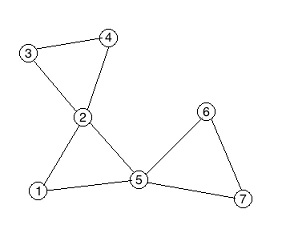【Codefoces487E/UOJ#30】Tourists Tarjan 点双连通分量 + 树链剖分
E. Tourists
There are n cities in Cyberland, numbered from 1 to n, connected by m bidirectional roads. The j-th road connects city aj and bj.
For tourists, souvenirs are sold in every city of Cyberland. In particular, city i sell it at a price of wi.
Now there are q queries for you to handle. There are two types of queries:
- "C a w": The price in city a is changed to w.
- "A a b": Now a tourist will travel from city a to b. He will choose a route, he also doesn't want to visit a city twice. He will buy souvenirs at the city where the souvenirs are the cheapest (possibly exactly at city a or b). You should output the minimum possible price that he can buy the souvenirs during his travel.
More formally, we can define routes as follow:
- A route is a sequence of cities [x1, x2, ..., xk], where k is a certain positive integer.
- For any 1 ≤ i < j ≤ k, xi ≠ xj.
- For any 1 ≤ i < k, there is a road connecting xi and xi + 1.
- The minimum price of the route is min(wx1, wx2, ..., wxk).
- The required answer is the minimum value of the minimum prices of all valid routes from a to b.
Input
The first line of input contains three integers n, m, q (1 ≤ n, m, q ≤ 105), separated by a single space.
Next n lines contain integers wi (1 ≤ wi ≤ 109).
Next m lines contain pairs of space-separated integers aj and bj (1 ≤ aj, bj ≤ n, aj ≠ bj).
It is guaranteed that there is at most one road connecting the same pair of cities. There is always at least one valid route between any two cities.
Next q lines each describe a query. The format is "C a w" or "A a b" (1 ≤ a, b ≤ n, 1 ≤ w ≤ 109).
Output
For each query of type "A", output the corresponding answer.
Examples
3 3 3
1
2
3
1 2
2 3
1 3
A 2 3
C 1 5
A 2 3
1
2
7 9 4
1
2
3
4
5
6
7
1 2
2 5
1 5
2 3
3 4
2 4
5 6
6 7
5 7
A 2 3
A 6 4
A 6 7
A 3 3
output
2
1
5
3
Note
For the second sample, an optimal routes are:
From 2 to 3 it is [2, 3].
From 6 to 4 it is [6, 5, 1, 2, 4].
From 6 to 7 it is [6, 5, 7].
From 3 to 3 it is [3].

Solution
中文题面见UOJ#30 : UOJ#30
思路比较显然,把图缩点重建,再利用数据结构去维护。
要求简单路径,显然可以考虑点双连通分量,我们先对图Tarjan求点双连通分量,然后将这些BCC维护一个最小值,然后缩成一个点,这样就形成一棵树,就可以树剖。
但是这里有一个问题,割点可能会存在于多个点双连通分量中,而这会比较蛋疼,因为割点的答案显然应该是距离它最小的那个。
所以我们对割点单独处理,每个割点新建一个点单独向它所在的所有点双连通分量连一条边; 这样我们就可以在询问的时候,搞定割点的问题了。
那么修改一个点,这个点所在点双的值就有可能发生改变,如果修改割点,那么就会对很多点双造成影响,所以要特殊处理这种情况。
但是我们发现,我们这样建出来的新图(树)一定是满足 块->割点->块->割点 的。
所以我们不妨定义一个点双维护的是,这个点双中除了它fa的割点的所有点的权值+连向它的割点的权值最小,这样如果修改一个割点,就只会影响到它的fa点双。
查询的时候,我们查询$<u,v>$,如果$LCA(u,v)$是一个割点,我们可以直接统计答案。 如果$LCA(u,v)$是一个点双,那么我们还得查它的fa割点的值。
点双内的最小值,可以用multiset来维护。
这样的查询复杂度是$O(log^{2}N)$,修改的复杂度是$O(logN)$,总的复杂度就是$O(Nlog^{2}N)$
对于Tarjan点双连通分量,网上有些人说要边入栈,但很多人却写的点入栈,其实都是可以的。 但是这道题,如果用边入栈的方法,在连边的时候会连出问题的,需要额外判,所以就用来点入栈的方法。
Code
#include<iostream> #include<cstdio> #include<algorithm> #include<cmath> #include<vector> #include<set> #include<cstring> using namespace std; inline int read() { int x=0; char ch=getchar(); while (ch<'0' || ch>'9') {ch=getchar();} while (ch>='0' && ch<='9') {x=x*10+ch-'0'; ch=getchar();} return x; } #define INF 0x7fffffff #define MAXN 100100 int N,M,Q,val[MAXN],Val[MAXN<<1]; struct RoadNode{int next,to;}road[MAXN<<1]; int tot=1,first[MAXN]; struct EdgeNode{int next,to;}edge[MAXN<<2]; int cnt=1,head[MAXN<<1]; inline void AddEdge(int u,int v) {cnt++; edge[cnt].next=head[u]; head[u]=cnt; edge[cnt].to=v;} inline void InsertEdge(int u,int v) {AddEdge(u,v); AddEdge(v,u);} multiset<int>::iterator ist; struct BlockNode { multiset<int>st; int val; inline void insert(int x) {st.insert(x); val=*st.begin();} inline void change(int x,int y) {st.erase(*st.find(x)); st.insert(y); val=*st.begin();} }B[MAXN<<1]; namespace Graph { inline void AddRoad(int u,int v) {tot++; road[tot].next=first[u]; first[u]=tot; road[tot].to=v;} inline void InsertRoad(int u,int v) {AddRoad(u,v); AddRoad(v,u);} int dfn[MAXN],low[MAXN],dfsn,bcc,now,belong[MAXN],size[MAXN],cut[MAXN],st[MAXN],top; inline void Tarjan(int now) { dfn[now]=low[now]=++dfsn; st[++top]=now; for (int i=first[now]; i; i=road[i].next) if (!dfn[road[i].to]) { Tarjan(road[i].to); low[now]=min(low[now],low[road[i].to]); if (dfn[now]<=low[road[i].to]) { bcc++; cut[now]=1; int tp=0; while (1) { tp=st[top--]; belong[tp]=bcc; if (cut[tp]) InsertEdge(tp+N,bcc); if (tp==road[i].to) break; } InsertEdge(now+N,bcc); } } else low[now]=min(low[now],dfn[road[i].to]); } inline void reBuild() { for (int i=1; i<=N; i++) if (!dfn[i]) Tarjan(i); for (int i=1; i<=N; i++) { if (i!=1) B[belong[i]].insert(val[i]); if (cut[i]) B[i+N].insert(INF); } } } namespace SegmentTree { struct SegmentTreeNode{int l,r,minx;}tree[MAXN<<3]; #define ls now<<1 #define rs now<<1|1 inline void Update(int now) {tree[now].minx=min(tree[ls].minx,tree[rs].minx);} inline void BuildTree(int now,int l,int r) { tree[now].l=l; tree[now].r=r; if (l==r) {tree[now].minx=Val[l]; return;} int mid=(l+r)>>1; BuildTree(ls,l,mid); BuildTree(rs,mid+1,r); Update(now); } inline void Change(int now,int pos,int D) { int l=tree[now].l,r=tree[now].r; if (l==r) {tree[now].minx=D; return;} int mid=(l+r)>>1; if (pos<=mid) Change(ls,pos,D); if (pos>mid) Change(rs,pos,D); Update(now); } inline int Query(int now,int L,int R) { int l=tree[now].l,r=tree[now].r; if (L<=l && R>=r) return tree[now].minx; int mid=(l+r)>>1,re=INF; if (L<=mid) re=min(re,Query(ls,L,R)); if (R>mid) re=min(re,Query(rs,L,R)); return re; } } namespace TreePartition { int fa[MAXN<<1],size[MAXN<<1],son[MAXN<<1],deep[MAXN<<1],pl[MAXN<<1],dfn,pre[MAXN<<1],top[MAXN<<1]; inline void DFS_1(int now) { size[now]=1; for (int i=head[now]; i; i=edge[i].next) if (edge[i].to!=fa[now]) { fa[edge[i].to]=now; deep[edge[i].to]=deep[now]+1; DFS_1(edge[i].to); size[now]+=size[edge[i].to]; if (size[son[now]]<size[edge[i].to]) son[now]=edge[i].to; } } inline void DFS_2(int now,int chain) { pl[now]=++dfn; pre[dfn]=now; top[now]=chain; Val[dfn]=B[now].val; if (son[now]) DFS_2(son[now],chain); for (int i=head[now]; i; i=edge[i].next) if (edge[i].to!=fa[now] && edge[i].to!=son[now]) DFS_2(edge[i].to,edge[i].to); } inline int LCA(int u,int v) { while (top[u]!=top[v]) { if (deep[top[u]]<deep[top[v]]) swap(u,v); u=fa[top[u]]; } if (deep[u]>deep[v]) swap(u,v); return u; } inline int Query(int x,int y) { x=Graph::cut[x]? x+N:Graph::belong[x]; y=Graph::cut[y]? y+N:Graph::belong[y]; int re=INF; int lca=LCA(x,y); if (lca<=Graph::bcc) lca=fa[lca]; re=val[lca-N]; while (top[x]!=top[y]) { if (deep[top[x]]<deep[top[y]]) swap(x,y); re=min(re,SegmentTree::Query(1,pl[top[x]],pl[x])); x=fa[top[x]]; } if (deep[x]>deep[y]) swap(x,y); re=min(re,SegmentTree::Query(1,pl[x],pl[y])); return re; } inline void Change(int pos,int D) {SegmentTree::Change(1,pl[pos],D);} } int main() { N=read(),M=read(),Q=read(); for (int i=1; i<=N; i++) val[i]=read(); for (int x,y,i=1; i<=M; i++) x=read(),y=read(),Graph::InsertRoad(x,y); Graph::reBuild(); // for (int i=1; i<=N; i++) printf("%d %d %d %d\n",dfn[i],low[i],cut[i],belong[i]); TreePartition::DFS_1(N+1); TreePartition::DFS_2(N+1,N+1); SegmentTree::BuildTree(1,1,TreePartition::dfn); while (Q--) { char opt[2]; scanf("%s",opt); int x=read(),y=read(); switch (opt[0]) { case 'C': if (x!=1) {B[Graph::belong[x]].change(val[x],y); TreePartition::Change(Graph::belong[x],B[Graph::belong[x]].val);} val[x]=y; break; case 'A': if (x==y) printf("%d\n",val[x]); else printf("%d\n",TreePartition::Query(x,y)); break; } } return 0; }
UOJ上跑的还挺快QAQ...就是死活压不到6000ms+....

 浙公网安备 33010602011771号
浙公网安备 33010602011771号